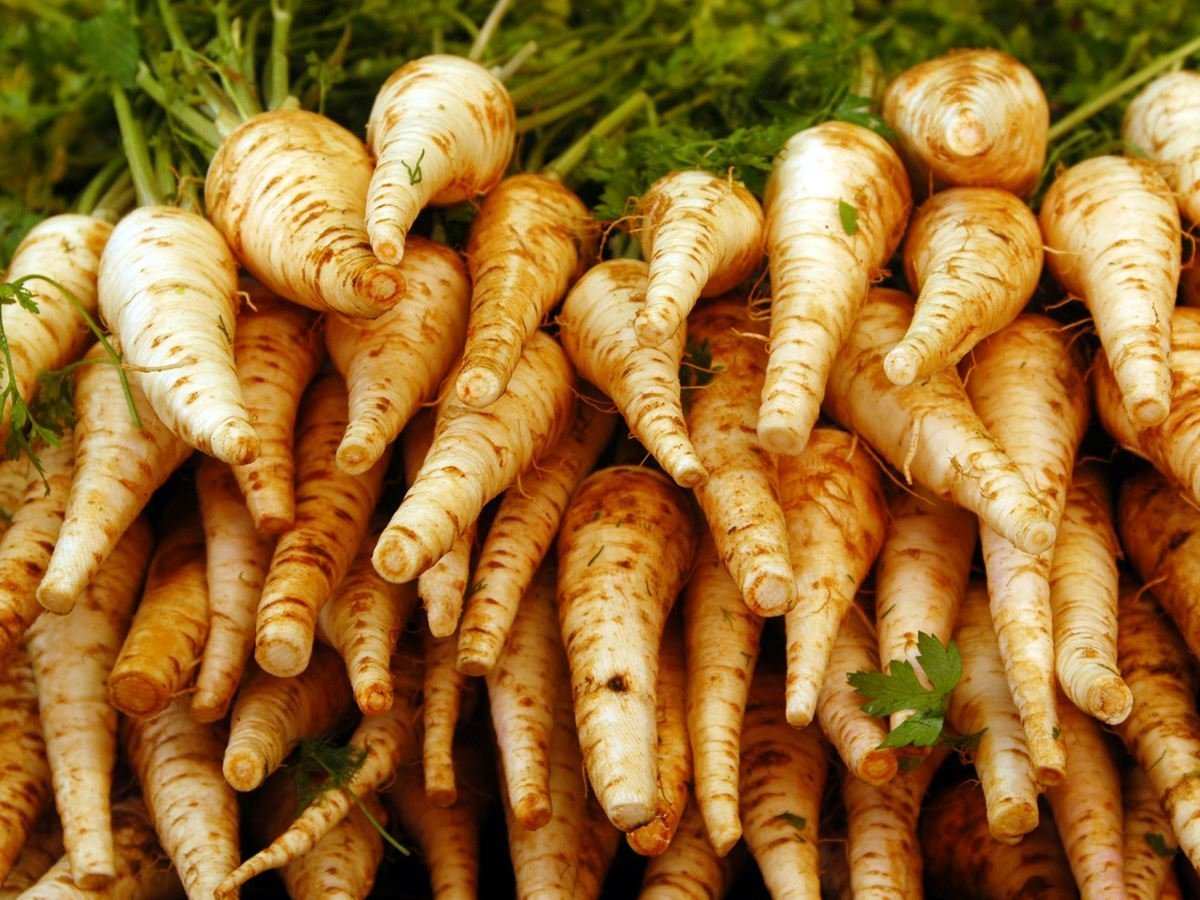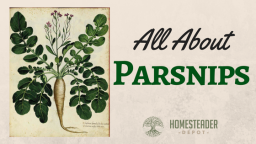Parsnips are not a very well-known garden vegetable, but they’re wonderful to grow, taste delicious, and keep  extraordinarily well in the garden over winter, or in your root cellar.
extraordinarily well in the garden over winter, or in your root cellar.
From the carrot family, parsnips, or Pastinaca sativa, resemble a pale carrot. They can be difficult to grow, but they’re worth the effort for their ability to keep through winter. They are the easiest garden vegetable to keep in the soil through the winter, to be dug up as needed, which makes them a wonderful choice for homesteaders.
Today, we’re going to discuss all things parsnip; how to plant, grow, harvest, and keep. Let’s get started!
Soil
Since parsnips need lots of room to root, they need very deep, well-cultivated soil. Naturally sandy soil is great, but if your soil tends to be more clay-like, you’ll have to prep your bed appropriately. Make sure to use lots of manure, cinder, and compost, and work as deep as 1 1/2′. The looser you can get your soil, the better!
Planting
You will want to make sure you have new parsnip seeds when you are planting them. Their seeds to not keep particularly well; so if they fail to sprout, old seed might be the culprit. However, it does take awhile to germinate, sometimes as long as 28 days, so be patient.
Plant very shallow, and only cover with a very thin, gentle layer. They can have difficulty growing through all but the lightest of soil. Plant in very well-watered soil. Ideally, you’d want to plant them 1/2″ apart, but this can be difficult to do with their small, light seeds, so do the best you can. You will want them to be in rows around 18-30″ apart.
Parsnips do not handle extreme heat very well, so plant either right after the last frost date in very early spring, or in the fall. Since they keep well through winter, they make a great fall crop.
Weeding and Thinning
Due to the lengthy germination time, you’ll have to make sure to keep any weeds out of your parsnip beds so they don’t overtake the small seedlings. A great solution to this is to mix radish in with your parsnips. Raddish germinates very quickly, and will show you where the parsnips will be so you can easily weed around them and keep them protected.
After the parsnips have come up, you can thin out about 3-6″ apart. Or, if you like, you can let them keep going and eat the thinnings! Parsnip greens are lovely and delicious.
Make sure to keep weeding all throughout the season.
Harvest
One of the things that make parsnip a wonderful winter crop is that cold weather enhances the natural sugars, making it sweeter as time goes on. So, it only makes parsnips better to leave them in the ground for at least three weeks of frosty weather. They are, surprisingly, most delicious if left in the garden all winter long! You can of course simply harvest throughout the winter as needed, which is probably the most practical and useful.
To harvests, parsnips really need to be dug out of the garden, as opposed to carrots which can normally be pulled up. If you pull up parsnips as you would carrots, they will most likely break. So, using a small spade, dig around the base of the parsnip, loosen the ground with your hand, and dig in until you feel the whole parsnip. Then, gently loosen and pull out, to avoid breakage.
Digging will, of course, be more difficult in winter, so plan your harvest according to how harsh your winter is.
Preservation
Parsnips don’t just preserve well in the garden! If you have a particularly harsh winter and won’t be planning on regularly digging up your parsnips through the colder months, there are still reliable options for preserving them through the winter.
The root pit method works particularly well for parsnips, and has been used for centuries. Simply lay them on the ground in a root cellar, cover with soil, then straw or leaves, and then with a tarp or plastic sheet. Or, if you do not have a root cellar, you can store parsnips between layers of damp sand in a tub or barrel in your tool shed or some other cold outbuilding.
They can, of course, simply be preserved by freezing, drying or canning as well:
To freeze, trim off the greens, then cut into 1/2″ cubes or in 3/4″ slices. Blanch for 2-3 minutes, then cool in ice-water baths. Package into Ziplock bags and freeze.
To dry, make sure you do not have parsnips so old that their core has become woody. Slice or shred with a mandoline, and place in a dehydrator at the appropriate setting for vegetables. Dry thoroughly, and store. These can be easily reconstituted by soaking overnight or adding to soups or stews. Or, it can be ground into powder to add to instant vegetable soup mix.
Parsnips are a wonderful, nutritious, and delicious garden vegetable. They can keep you stocked with a delicious, starchy vegetable, no matter how you choose to harvest or preserve them.
If you enjoyed this, you might also like….
Long-Term Survival for Homesteaders…
Natural Healing Secrets You Need to Know…
Effective Primal Diet Hacks…

